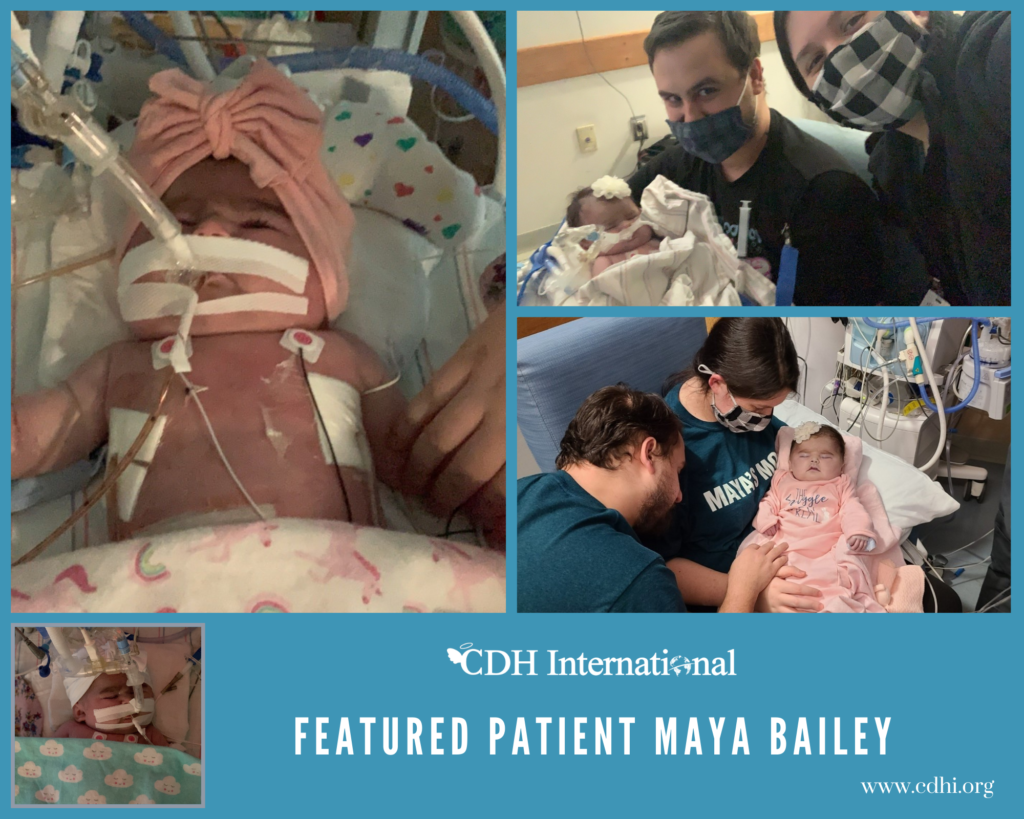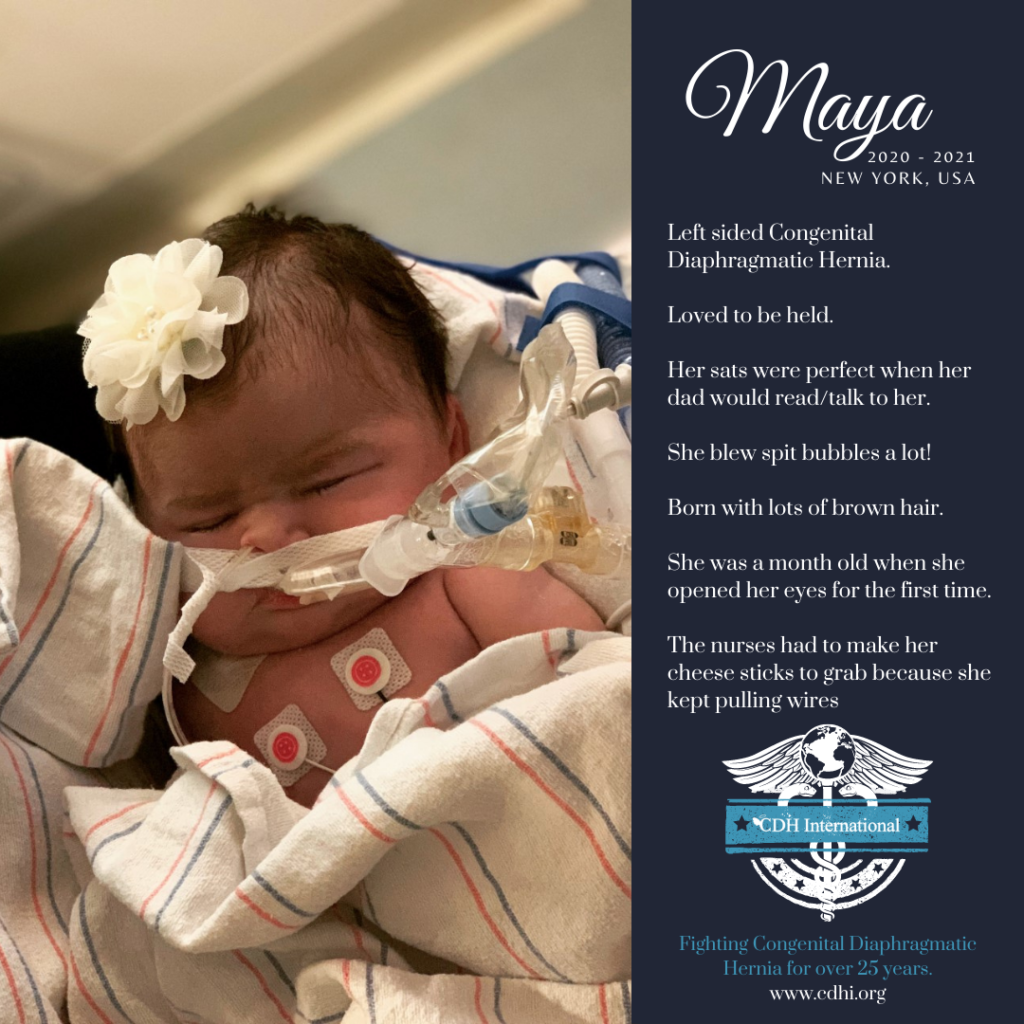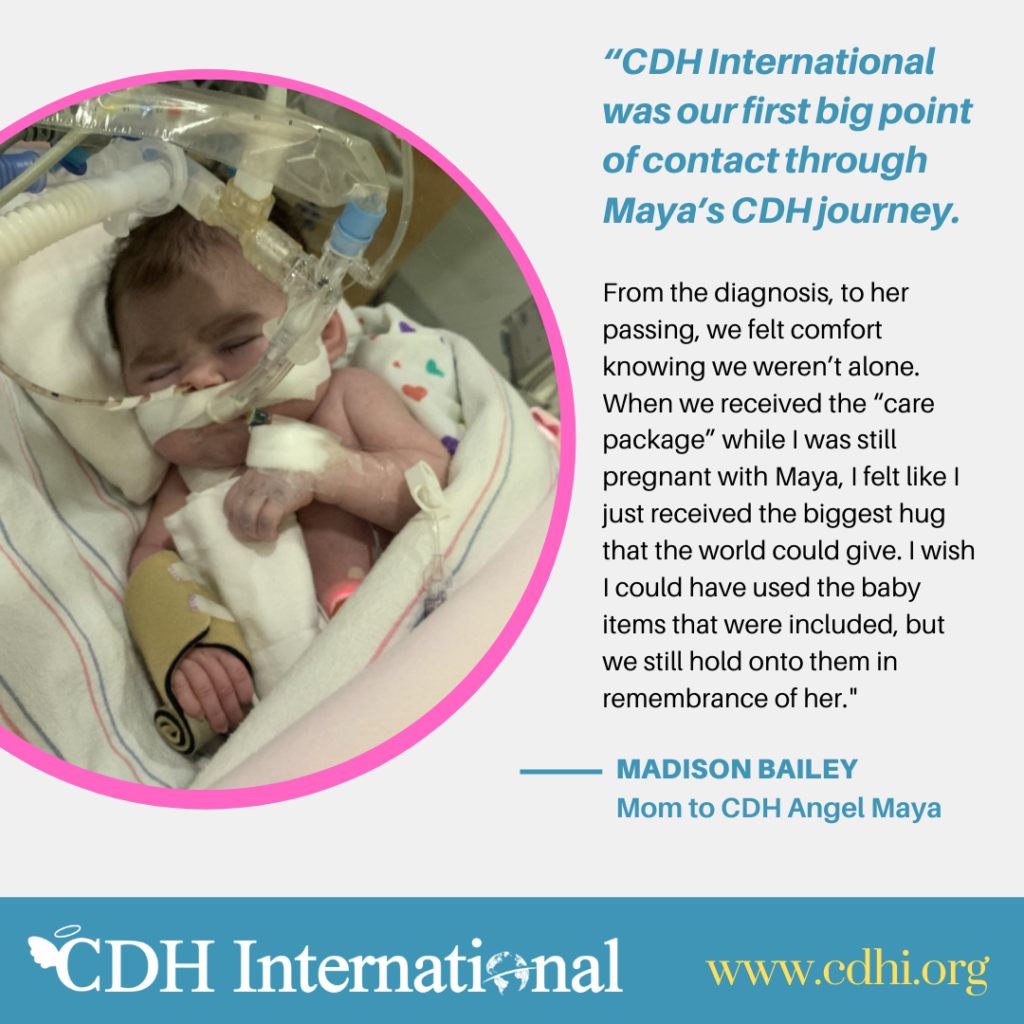CDH International’s featured patient of the week is CDH angel Maya Bailey. Maya is the daughter of Michael and Madison Bailey. Her mom had this to share with us about her daughter’s courageous battle with CDH:
“Maya was diagnosed with LCDH (left sided congenital diaphragmatic hernia) when I was 20 weeks pregnant. She had stomach, spleen, and intestines in her chest. Maya was born December 4th, 2020 at 3:22am. She was immediately intubated and she had a Salem sump tube placed in her nose going into her stomach to pull out any gases, stomach contents etc.
On December 5th, she was put on ECMO. Although it was anticipated that she wouldn’t need it, the doctors let us know this would be her best chance at survival. ECMO is short for Extracorporeal Membrane Oxygenation. Blood is pumped outside of her body to a heart-lung machine that removes carbon dioxide and sends oxygen-filled blood back to her tissues in the body. She was successful going on the machine.
On December 8th, we got a call about 7:15 in the morning that there was an emergency at the hospital. The ECMO machine had clotted, taking away the blood and oxygen from Maya that was keeping her alive. They did compressions on her for 25 minutes while the ECMO techs changed out the ECMO circuit and got everything set back up. Because of this, the doctors warned us there could be brain damage. She began to have seizures which were indicative of trauma to the brain. She was monitored on an EEG machine for a few days.
On December 12th, the EEG was removed from her head, as the seizures had stopped. Each day after this felt like forever as we were just waiting for her to improve and get off the ECMO machine. They trialed a few times to see if she could handle coming off, however each attempt was unsuccessful.
On December 25th, she developed an infection, MSSA. Because the bacteria sticks to plastic, the combination of many lines going in and out of her body, as well as the ECMO machine, the infection was finding very difficult to clear up.
On December 30th, she looked her best. The doctors told us this was the best shot at getting her off ECMO, otherwise the infection may never clear up. They warned us she might not survive, but we knew she was a little fighter. She came off of ECMO successfully and seemed to be doing great.
The next day, December 31st she had a buildup of fluid in her lungs and chest, she was increasingly swollen, and drowning in fluid. They put in a chest tube to relieve this pressure and estimated 1-2 days that it would be in. They would keep the chest tube in until fluid stopped draining from her body. The next day, January 1st, the infection cleared up! They scheduled her CDH repair surgery for January 5th and this was successful as well.
Four more days passed and on January 9th, we got to hold Maya for the first time. Holding her and seeing how calm she was, turned off every bad thing. I was the happiest I have ever been, my life was complete.”

The next day, January 10th, her sump, the tube pulling the stomach contents out was switched to gravity, meaning things were improving and they didn’t have to continually pull out contents, they would come out on their own if necessary.
On January 11th, the next day, she developed a marking on her left side, from her belly to her thigh. She was seen by multiple departments over the course of a few days in regards to this, to find that it was an injury to her kidney. It did get better after a while which was positive.
Her sump was pulled out on January 13th because nothing was coming out of the tube, all good signs! Although unfortunately it did go back in the next day after she puked. The next day she was scheduled for an MRI and to go to the cath lab. At this point her chest tube had not come out, it was continuously draining, which should not have been happening. They discovered that she had a clot in her thoracic duct, part of the lymphatic system, causing the fluid to leak into her body. Also on this day she got a new picc line, for the 3rd time, this one had clotted. The picc line is a tube inserted into the vein and goes up near the heart. This tube was used to administer most of her medications and her nutrients because she couldn’t take feeds. Along with this picc line she also had an arterial line that measured her blood pressure at all times. More times than we could count she had extra IV’s placed, for extra medication that couldn’t go through the picc line.
On January 16th they thought she had more seizures, and this was monitored throughout the next few days. This stumped the neurologist because this wasn’t normal this far out from her brain trauma. It was also noted on this day that she was bleeding from her sump, possibly bleeding in her stomach from irritation from the tube.
On January 20th, they placed an additional chest tube on the left side of her chest, and replaced the one on the right for the third time. The results also started coming back from her MRI that was done on the 14th. They discovered she had a pocket in her aorta, which causes blood to move around in the wrong direction. This left the potential to clot at any time, cause her heart to stop, or throw a clot to her brain. It was also confirmed that she did have brain damage, we just didn’t know the extent yet.
January 22nd, they noticed she had green mucus in her sump, coming from her stomach. They took her up for a GI study, two times to make sure her intestines weren’t twisted or there was a blockage etc.
The next day, January 23rd, we met with her team around 10am, the neurologist, the neonatologist, the nurse practitioner, and her nurse of the day. The brain damage was extensive. This conversation was such a blur. Based on the damage to her brain, it was likely she would be immobile her entire life, she wouldn’t know who we were, she wouldn’t live. Along with her CDH that turned out to be more severe than anticipated, pulmonary hypertension, the pocket in her aorta, the lymphatic disorder, and many other issues, it was determined that Maya had very little chance of survival, and even if she did survive and leave the hospital, she wouldn’t be living.
We decided this was not something a child should endure and made the decision to pull her life support. They allowed us to have visitors on her last day. The first and last time her family would meet her. We held her through her last moments, until she went into God’s arms. 10:53 pm we said we will see you later to our little lion. I can only hope that I will see her again, and I will not let her go.”







